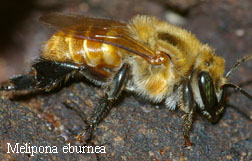 |
About
800 species of stingless bees are found throughout tropical regions of
the World, ranging from such ecologically diverse habitats as humid
rainforest to dry savanna or cerrado. Their greatest diversity and
abundance, however, is in the Amazonian rain forest. While they range in
size from only a few mm to larger than the honey bee (Apis mellifera),
they all live in colonies where they care for the brood (the new bees)
laid by the colony mother, or queen. Some colonies contains thousands of
individuals. Working females are constantly flying in and out of the
colony to gather what is needed for sustaining the large family. Most
importantly the foraging workers gather honey and pollen used as
provision for the young bees (larvae) being reared. The bees will
usually store a large amount of both honey and pollen during favorable
times which they can use later. If properly managed, the honey can be
harvested from the stingless bees without damaging or weakening the
colony. The taste of stingless bee honey is experienced different by
different people, but generally it is called very sweet and pleasant,
almost acidic and with a boost of floral fragrances. The highly desired Tetragonisca honey is a little more acidic compared to honey from Melipona due to the plants visited by these bees. |
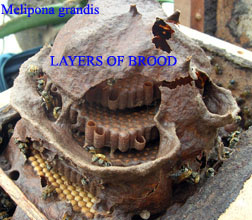
|
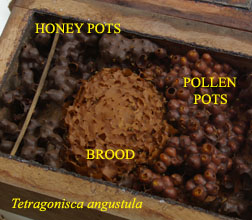 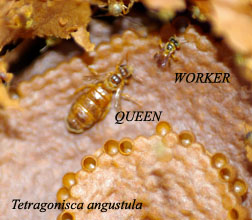
|
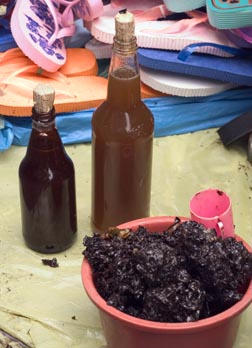 |
The
use of stingless bee honey is known from all of the regions where these
bees are found, with possibly most interest in the cultivation in Latin
America and Australia (called sugar-bags there). The best documented
use of honey from stingless bees comes from the Mayan civilization in
the Yucatan peninsula where they use Melipona beechei. Here the
bee is called "xunancab" and beekeeping of this species originated
independent of hive beekeeping with honey bees in the Old World.
"Xunancab" was in the Maya civilization only second in importance to
corn (maize) in people's lives and rituals. The honey was used both as
honey, but also fermented as "balche", their alcoholic drink. Today the
tradition of keeping stingless bees has largely been abandoned in favor
of imported honey bees (Apis mellifera) which yields more honey. In Peru stingless bee honey has been used in traditional medicine for centuries or more, but the actual beekeeping has been limited and most honey for the local market is collected by cutting down trees with entire bee colonies, which are then left to die. Traditionally honey from stingless bees are harvested by squeezing the honey pots with the bare hands and collecting the honey as it pour out of the nest, often contaminated with pollen and brood (bee larvae). This makes the honey particular susceptible to fermentation. The honey is widely used and often sold at local markets. Here the honey may serve both as a sweetener, but more often as part of folk medicine. Stingless bee honey are an important part of different treatments against throat infections (common cold, cough), but are also used in the treatment of fertility problems. While the honey possesses anti-bacterial properties dependent on the botanical origin of the honey, the combination of stingless bee honey with jungle herbs may alter or improve the properties of each remedy to be more specific in the treatment. A typical mixture to combat fever include stingless bee honey (1 part) mixed with sugar cane alcohol (5 parts) and left with the local plant "chuchu-huasi" (Maytenus krukovii) and pollen.
http://www.melipona.org
|
Wednesday, March 20, 2013
Honey from stingless bees
Labels:
Stingless Bee
Subscribe to:
Post Comments (Atom)
No comments:
Post a Comment